The Role of Project Management in Construction Projects
VerifiedAdded on 2021/06/14
|13
|3241
|43
Report
AI Summary
This report reflects on the student's learning experience regarding the role of project management in construction projects. It emphasizes the importance of project management for successful project outcomes, covering key areas such as risk management, ethical considerations, and various project ...
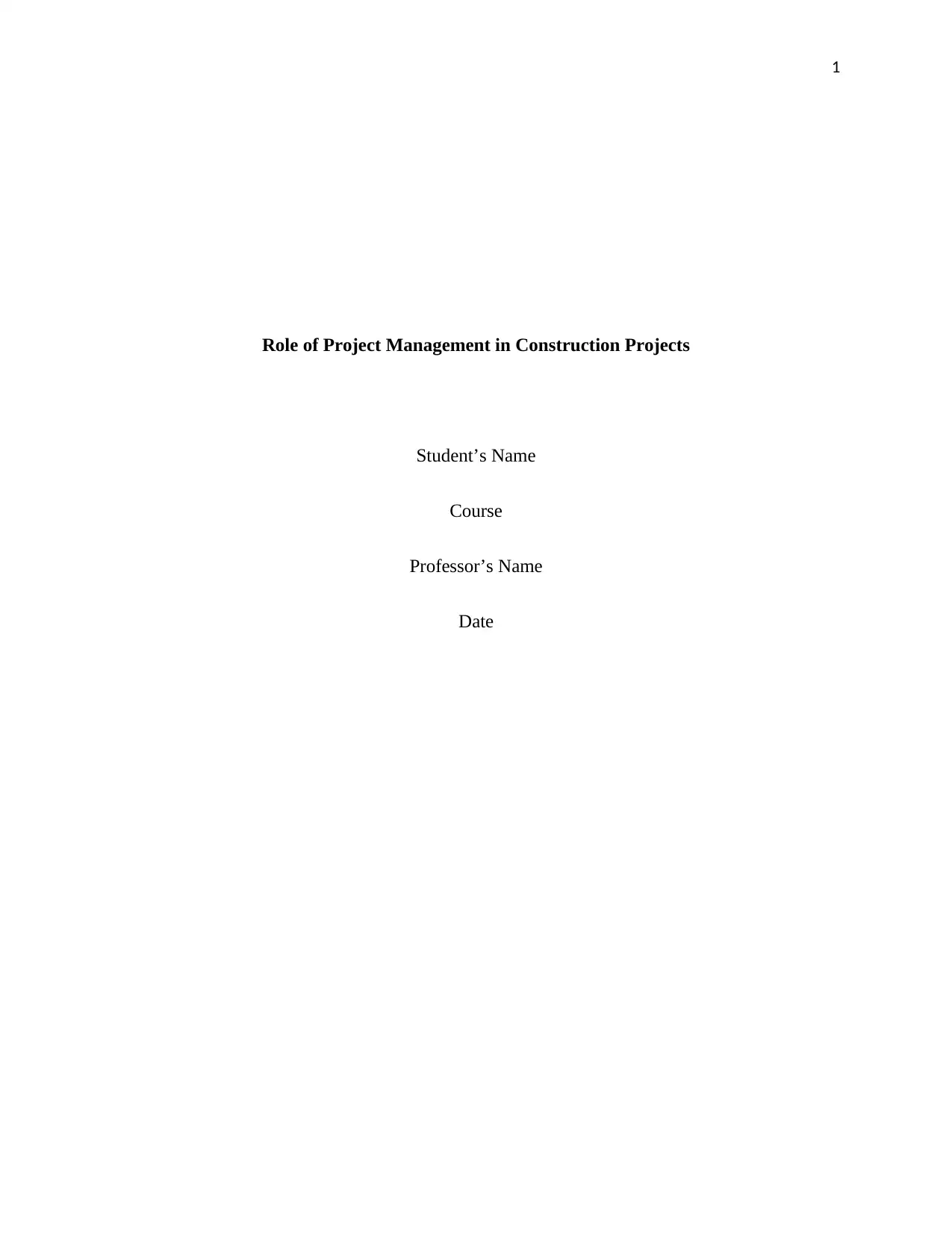
1
Role of Project Management in Construction Projects
Student’s Name
Course
Professor’s Name
Date
Role of Project Management in Construction Projects
Student’s Name
Course
Professor’s Name
Date
Paraphrase This Document
Need a fresh take? Get an instant paraphrase of this document with our AI Paraphraser

2
Table of Contents
Executive Summary.........................................................................................................................3
Introduction......................................................................................................................................4
Project Risk Management................................................................................................................4
Ethics and project management.......................................................................................................5
Methodologies of project management...........................................................................................8
Learning Experience........................................................................................................................8
Conclusion.......................................................................................................................................8
Bibliography....................................................................................................................................9
Table of Contents
Executive Summary.........................................................................................................................3
Introduction......................................................................................................................................4
Project Risk Management................................................................................................................4
Ethics and project management.......................................................................................................5
Methodologies of project management...........................................................................................8
Learning Experience........................................................................................................................8
Conclusion.......................................................................................................................................8
Bibliography....................................................................................................................................9
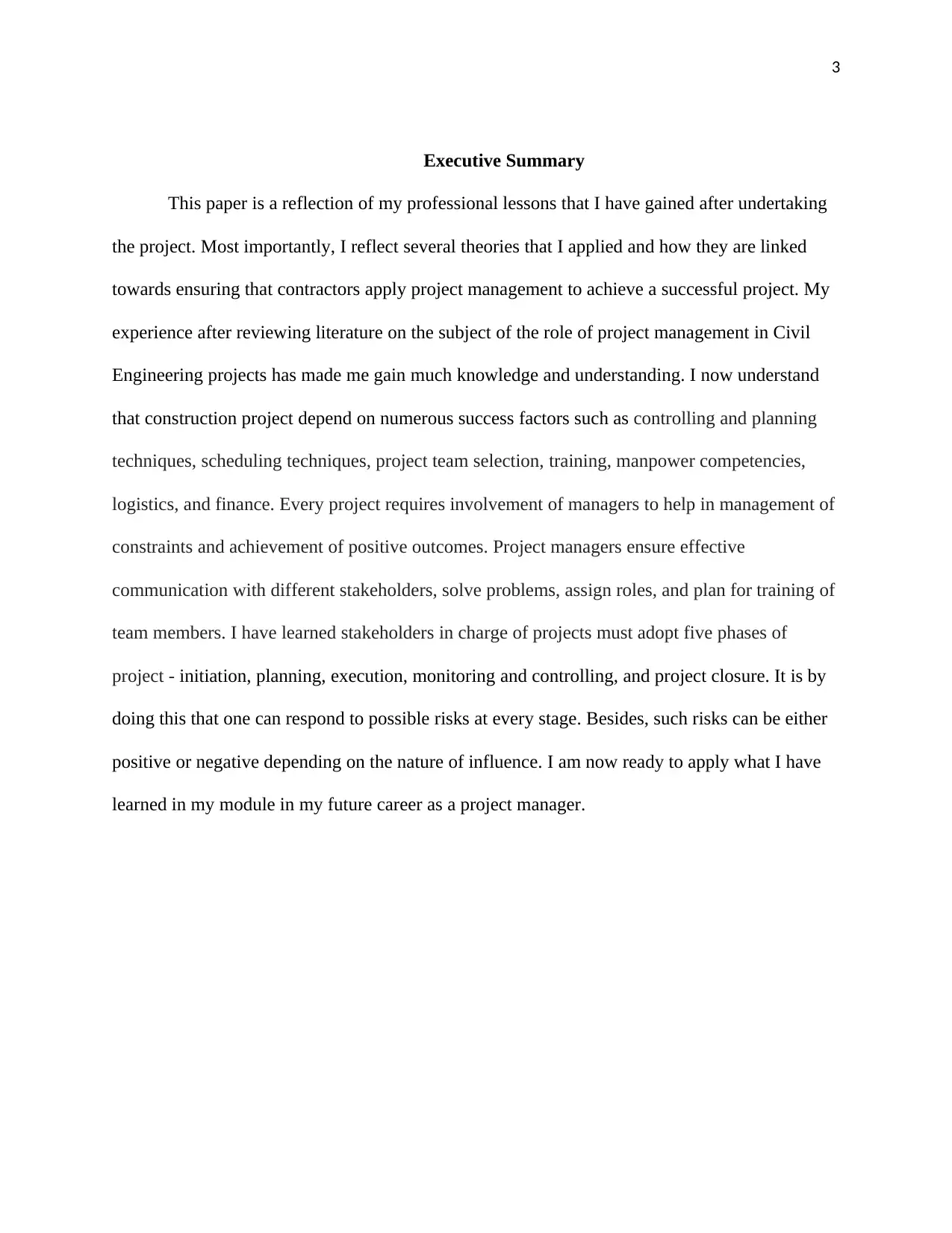
3
Executive Summary
This paper is a reflection of my professional lessons that I have gained after undertaking
the project. Most importantly, I reflect several theories that I applied and how they are linked
towards ensuring that contractors apply project management to achieve a successful project. My
experience after reviewing literature on the subject of the role of project management in Civil
Engineering projects has made me gain much knowledge and understanding. I now understand
that construction project depend on numerous success factors such as controlling and planning
techniques, scheduling techniques, project team selection, training, manpower competencies,
logistics, and finance. Every project requires involvement of managers to help in management of
constraints and achievement of positive outcomes. Project managers ensure effective
communication with different stakeholders, solve problems, assign roles, and plan for training of
team members. I have learned stakeholders in charge of projects must adopt five phases of
project - initiation, planning, execution, monitoring and controlling, and project closure. It is by
doing this that one can respond to possible risks at every stage. Besides, such risks can be either
positive or negative depending on the nature of influence. I am now ready to apply what I have
learned in my module in my future career as a project manager.
Executive Summary
This paper is a reflection of my professional lessons that I have gained after undertaking
the project. Most importantly, I reflect several theories that I applied and how they are linked
towards ensuring that contractors apply project management to achieve a successful project. My
experience after reviewing literature on the subject of the role of project management in Civil
Engineering projects has made me gain much knowledge and understanding. I now understand
that construction project depend on numerous success factors such as controlling and planning
techniques, scheduling techniques, project team selection, training, manpower competencies,
logistics, and finance. Every project requires involvement of managers to help in management of
constraints and achievement of positive outcomes. Project managers ensure effective
communication with different stakeholders, solve problems, assign roles, and plan for training of
team members. I have learned stakeholders in charge of projects must adopt five phases of
project - initiation, planning, execution, monitoring and controlling, and project closure. It is by
doing this that one can respond to possible risks at every stage. Besides, such risks can be either
positive or negative depending on the nature of influence. I am now ready to apply what I have
learned in my module in my future career as a project manager.
⊘ This is a preview!⊘
Do you want full access?
Subscribe today to unlock all pages.

Trusted by 1+ million students worldwide
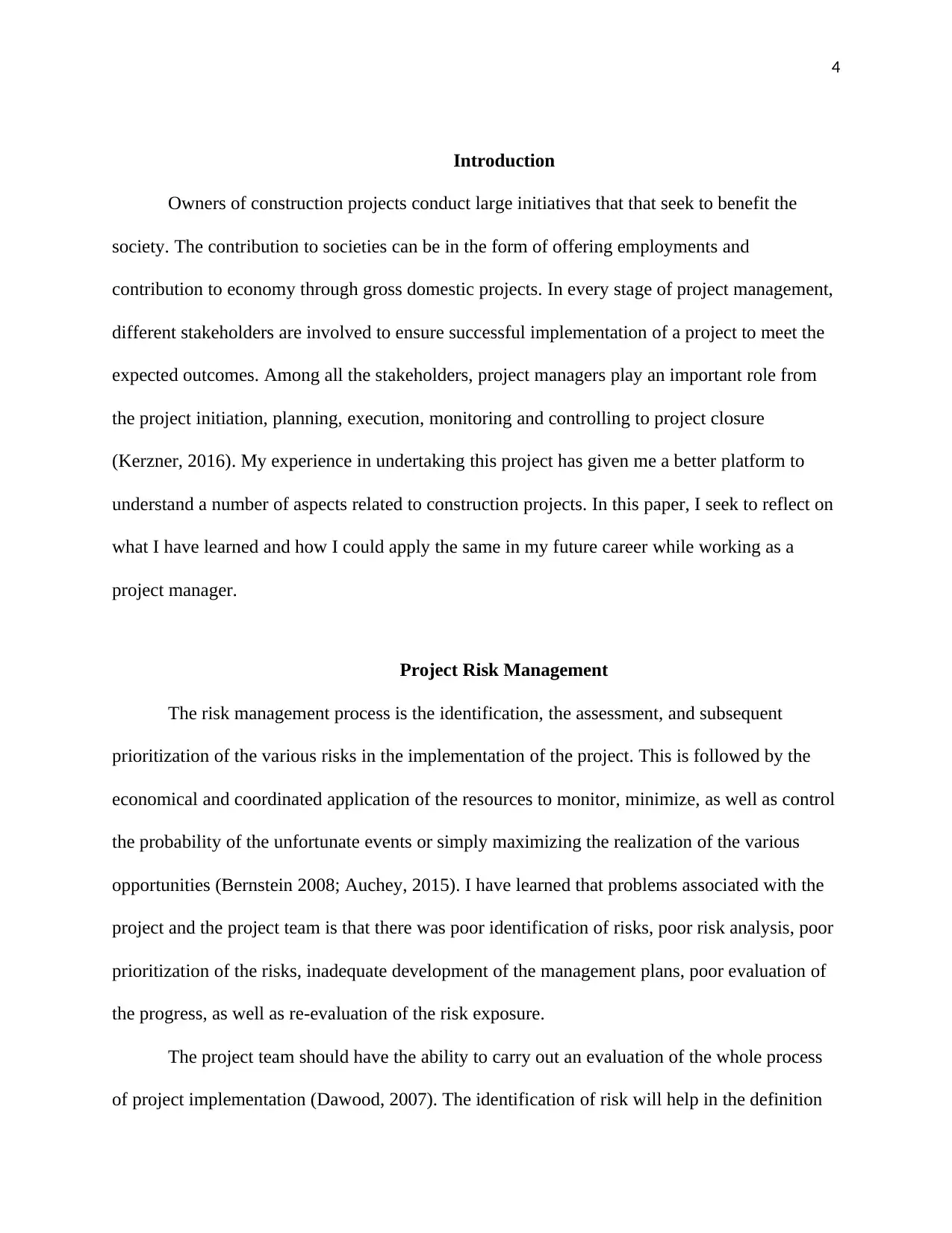
4
Introduction
Owners of construction projects conduct large initiatives that that seek to benefit the
society. The contribution to societies can be in the form of offering employments and
contribution to economy through gross domestic projects. In every stage of project management,
different stakeholders are involved to ensure successful implementation of a project to meet the
expected outcomes. Among all the stakeholders, project managers play an important role from
the project initiation, planning, execution, monitoring and controlling to project closure
(Kerzner, 2016). My experience in undertaking this project has given me a better platform to
understand a number of aspects related to construction projects. In this paper, I seek to reflect on
what I have learned and how I could apply the same in my future career while working as a
project manager.
Project Risk Management
The risk management process is the identification, the assessment, and subsequent
prioritization of the various risks in the implementation of the project. This is followed by the
economical and coordinated application of the resources to monitor, minimize, as well as control
the probability of the unfortunate events or simply maximizing the realization of the various
opportunities (Bernstein 2008; Auchey, 2015). I have learned that problems associated with the
project and the project team is that there was poor identification of risks, poor risk analysis, poor
prioritization of the risks, inadequate development of the management plans, poor evaluation of
the progress, as well as re-evaluation of the risk exposure.
The project team should have the ability to carry out an evaluation of the whole process
of project implementation (Dawood, 2007). The identification of risk will help in the definition
Introduction
Owners of construction projects conduct large initiatives that that seek to benefit the
society. The contribution to societies can be in the form of offering employments and
contribution to economy through gross domestic projects. In every stage of project management,
different stakeholders are involved to ensure successful implementation of a project to meet the
expected outcomes. Among all the stakeholders, project managers play an important role from
the project initiation, planning, execution, monitoring and controlling to project closure
(Kerzner, 2016). My experience in undertaking this project has given me a better platform to
understand a number of aspects related to construction projects. In this paper, I seek to reflect on
what I have learned and how I could apply the same in my future career while working as a
project manager.
Project Risk Management
The risk management process is the identification, the assessment, and subsequent
prioritization of the various risks in the implementation of the project. This is followed by the
economical and coordinated application of the resources to monitor, minimize, as well as control
the probability of the unfortunate events or simply maximizing the realization of the various
opportunities (Bernstein 2008; Auchey, 2015). I have learned that problems associated with the
project and the project team is that there was poor identification of risks, poor risk analysis, poor
prioritization of the risks, inadequate development of the management plans, poor evaluation of
the progress, as well as re-evaluation of the risk exposure.
The project team should have the ability to carry out an evaluation of the whole process
of project implementation (Dawood, 2007). The identification of risk will help in the definition
Paraphrase This Document
Need a fresh take? Get an instant paraphrase of this document with our AI Paraphraser
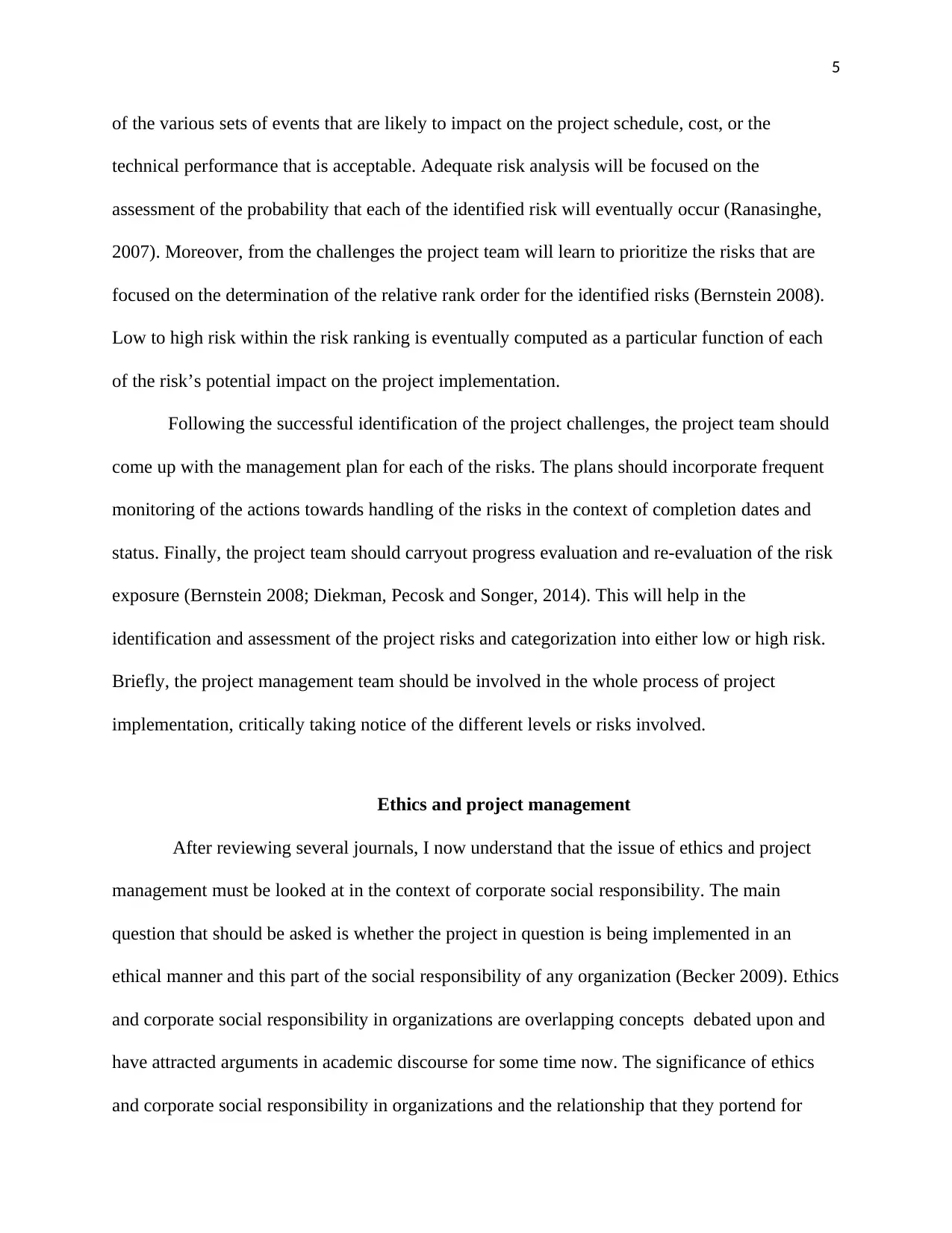
5
of the various sets of events that are likely to impact on the project schedule, cost, or the
technical performance that is acceptable. Adequate risk analysis will be focused on the
assessment of the probability that each of the identified risk will eventually occur (Ranasinghe,
2007). Moreover, from the challenges the project team will learn to prioritize the risks that are
focused on the determination of the relative rank order for the identified risks (Bernstein 2008).
Low to high risk within the risk ranking is eventually computed as a particular function of each
of the risk’s potential impact on the project implementation.
Following the successful identification of the project challenges, the project team should
come up with the management plan for each of the risks. The plans should incorporate frequent
monitoring of the actions towards handling of the risks in the context of completion dates and
status. Finally, the project team should carryout progress evaluation and re-evaluation of the risk
exposure (Bernstein 2008; Diekman, Pecosk and Songer, 2014). This will help in the
identification and assessment of the project risks and categorization into either low or high risk.
Briefly, the project management team should be involved in the whole process of project
implementation, critically taking notice of the different levels or risks involved.
Ethics and project management
After reviewing several journals, I now understand that the issue of ethics and project
management must be looked at in the context of corporate social responsibility. The main
question that should be asked is whether the project in question is being implemented in an
ethical manner and this part of the social responsibility of any organization (Becker 2009). Ethics
and corporate social responsibility in organizations are overlapping concepts debated upon and
have attracted arguments in academic discourse for some time now. The significance of ethics
and corporate social responsibility in organizations and the relationship that they portend for
of the various sets of events that are likely to impact on the project schedule, cost, or the
technical performance that is acceptable. Adequate risk analysis will be focused on the
assessment of the probability that each of the identified risk will eventually occur (Ranasinghe,
2007). Moreover, from the challenges the project team will learn to prioritize the risks that are
focused on the determination of the relative rank order for the identified risks (Bernstein 2008).
Low to high risk within the risk ranking is eventually computed as a particular function of each
of the risk’s potential impact on the project implementation.
Following the successful identification of the project challenges, the project team should
come up with the management plan for each of the risks. The plans should incorporate frequent
monitoring of the actions towards handling of the risks in the context of completion dates and
status. Finally, the project team should carryout progress evaluation and re-evaluation of the risk
exposure (Bernstein 2008; Diekman, Pecosk and Songer, 2014). This will help in the
identification and assessment of the project risks and categorization into either low or high risk.
Briefly, the project management team should be involved in the whole process of project
implementation, critically taking notice of the different levels or risks involved.
Ethics and project management
After reviewing several journals, I now understand that the issue of ethics and project
management must be looked at in the context of corporate social responsibility. The main
question that should be asked is whether the project in question is being implemented in an
ethical manner and this part of the social responsibility of any organization (Becker 2009). Ethics
and corporate social responsibility in organizations are overlapping concepts debated upon and
have attracted arguments in academic discourse for some time now. The significance of ethics
and corporate social responsibility in organizations and the relationship that they portend for
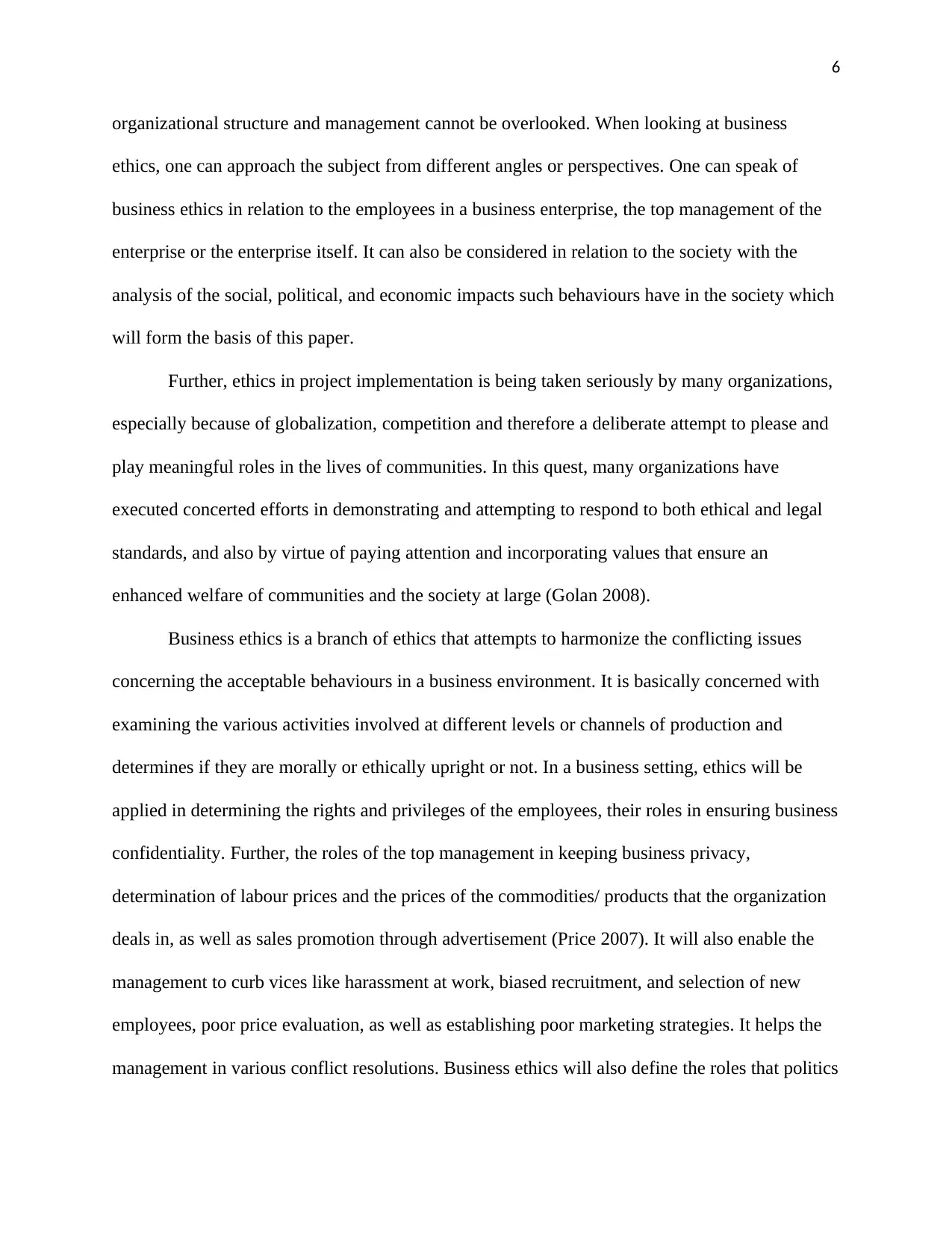
6
organizational structure and management cannot be overlooked. When looking at business
ethics, one can approach the subject from different angles or perspectives. One can speak of
business ethics in relation to the employees in a business enterprise, the top management of the
enterprise or the enterprise itself. It can also be considered in relation to the society with the
analysis of the social, political, and economic impacts such behaviours have in the society which
will form the basis of this paper.
Further, ethics in project implementation is being taken seriously by many organizations,
especially because of globalization, competition and therefore a deliberate attempt to please and
play meaningful roles in the lives of communities. In this quest, many organizations have
executed concerted efforts in demonstrating and attempting to respond to both ethical and legal
standards, and also by virtue of paying attention and incorporating values that ensure an
enhanced welfare of communities and the society at large (Golan 2008).
Business ethics is a branch of ethics that attempts to harmonize the conflicting issues
concerning the acceptable behaviours in a business environment. It is basically concerned with
examining the various activities involved at different levels or channels of production and
determines if they are morally or ethically upright or not. In a business setting, ethics will be
applied in determining the rights and privileges of the employees, their roles in ensuring business
confidentiality. Further, the roles of the top management in keeping business privacy,
determination of labour prices and the prices of the commodities/ products that the organization
deals in, as well as sales promotion through advertisement (Price 2007). It will also enable the
management to curb vices like harassment at work, biased recruitment, and selection of new
employees, poor price evaluation, as well as establishing poor marketing strategies. It helps the
management in various conflict resolutions. Business ethics will also define the roles that politics
organizational structure and management cannot be overlooked. When looking at business
ethics, one can approach the subject from different angles or perspectives. One can speak of
business ethics in relation to the employees in a business enterprise, the top management of the
enterprise or the enterprise itself. It can also be considered in relation to the society with the
analysis of the social, political, and economic impacts such behaviours have in the society which
will form the basis of this paper.
Further, ethics in project implementation is being taken seriously by many organizations,
especially because of globalization, competition and therefore a deliberate attempt to please and
play meaningful roles in the lives of communities. In this quest, many organizations have
executed concerted efforts in demonstrating and attempting to respond to both ethical and legal
standards, and also by virtue of paying attention and incorporating values that ensure an
enhanced welfare of communities and the society at large (Golan 2008).
Business ethics is a branch of ethics that attempts to harmonize the conflicting issues
concerning the acceptable behaviours in a business environment. It is basically concerned with
examining the various activities involved at different levels or channels of production and
determines if they are morally or ethically upright or not. In a business setting, ethics will be
applied in determining the rights and privileges of the employees, their roles in ensuring business
confidentiality. Further, the roles of the top management in keeping business privacy,
determination of labour prices and the prices of the commodities/ products that the organization
deals in, as well as sales promotion through advertisement (Price 2007). It will also enable the
management to curb vices like harassment at work, biased recruitment, and selection of new
employees, poor price evaluation, as well as establishing poor marketing strategies. It helps the
management in various conflict resolutions. Business ethics will also define the roles that politics
⊘ This is a preview!⊘
Do you want full access?
Subscribe today to unlock all pages.

Trusted by 1+ million students worldwide
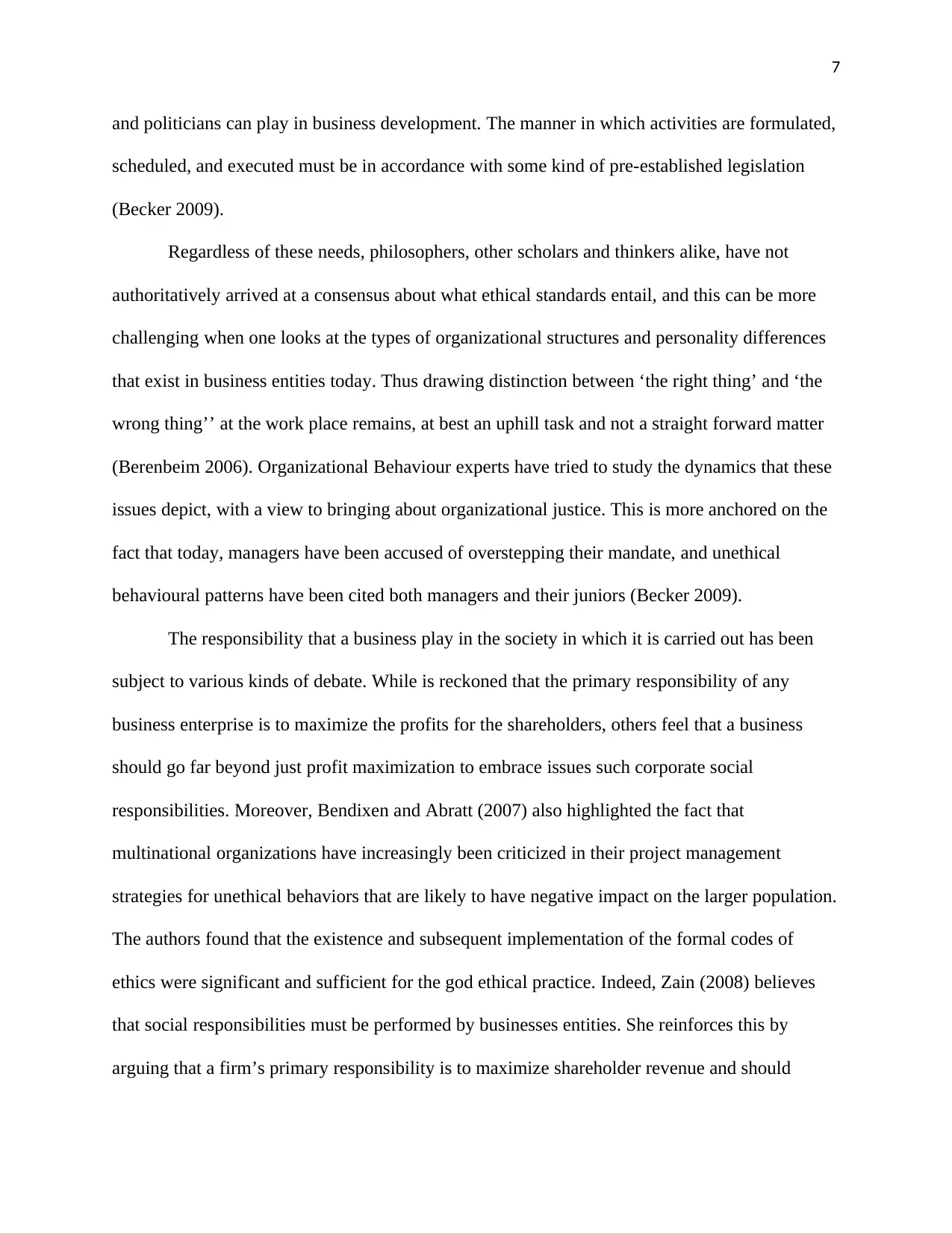
7
and politicians can play in business development. The manner in which activities are formulated,
scheduled, and executed must be in accordance with some kind of pre-established legislation
(Becker 2009).
Regardless of these needs, philosophers, other scholars and thinkers alike, have not
authoritatively arrived at a consensus about what ethical standards entail, and this can be more
challenging when one looks at the types of organizational structures and personality differences
that exist in business entities today. Thus drawing distinction between ‘the right thing’ and ‘the
wrong thing’’ at the work place remains, at best an uphill task and not a straight forward matter
(Berenbeim 2006). Organizational Behaviour experts have tried to study the dynamics that these
issues depict, with a view to bringing about organizational justice. This is more anchored on the
fact that today, managers have been accused of overstepping their mandate, and unethical
behavioural patterns have been cited both managers and their juniors (Becker 2009).
The responsibility that a business play in the society in which it is carried out has been
subject to various kinds of debate. While is reckoned that the primary responsibility of any
business enterprise is to maximize the profits for the shareholders, others feel that a business
should go far beyond just profit maximization to embrace issues such corporate social
responsibilities. Moreover, Bendixen and Abratt (2007) also highlighted the fact that
multinational organizations have increasingly been criticized in their project management
strategies for unethical behaviors that are likely to have negative impact on the larger population.
The authors found that the existence and subsequent implementation of the formal codes of
ethics were significant and sufficient for the god ethical practice. Indeed, Zain (2008) believes
that social responsibilities must be performed by businesses entities. She reinforces this by
arguing that a firm’s primary responsibility is to maximize shareholder revenue and should
and politicians can play in business development. The manner in which activities are formulated,
scheduled, and executed must be in accordance with some kind of pre-established legislation
(Becker 2009).
Regardless of these needs, philosophers, other scholars and thinkers alike, have not
authoritatively arrived at a consensus about what ethical standards entail, and this can be more
challenging when one looks at the types of organizational structures and personality differences
that exist in business entities today. Thus drawing distinction between ‘the right thing’ and ‘the
wrong thing’’ at the work place remains, at best an uphill task and not a straight forward matter
(Berenbeim 2006). Organizational Behaviour experts have tried to study the dynamics that these
issues depict, with a view to bringing about organizational justice. This is more anchored on the
fact that today, managers have been accused of overstepping their mandate, and unethical
behavioural patterns have been cited both managers and their juniors (Becker 2009).
The responsibility that a business play in the society in which it is carried out has been
subject to various kinds of debate. While is reckoned that the primary responsibility of any
business enterprise is to maximize the profits for the shareholders, others feel that a business
should go far beyond just profit maximization to embrace issues such corporate social
responsibilities. Moreover, Bendixen and Abratt (2007) also highlighted the fact that
multinational organizations have increasingly been criticized in their project management
strategies for unethical behaviors that are likely to have negative impact on the larger population.
The authors found that the existence and subsequent implementation of the formal codes of
ethics were significant and sufficient for the god ethical practice. Indeed, Zain (2008) believes
that social responsibilities must be performed by businesses entities. She reinforces this by
arguing that a firm’s primary responsibility is to maximize shareholder revenue and should
Paraphrase This Document
Need a fresh take? Get an instant paraphrase of this document with our AI Paraphraser
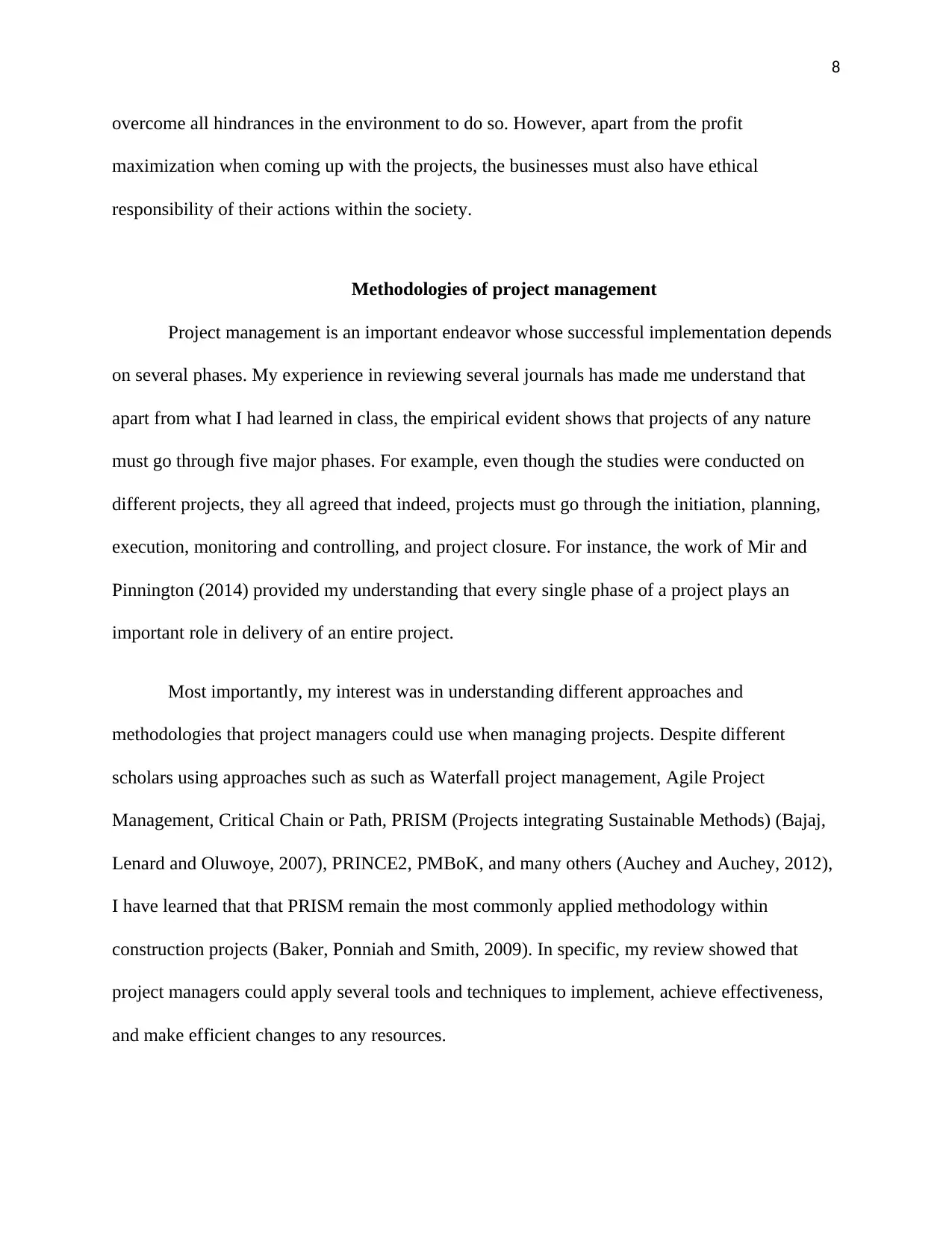
8
overcome all hindrances in the environment to do so. However, apart from the profit
maximization when coming up with the projects, the businesses must also have ethical
responsibility of their actions within the society.
Methodologies of project management
Project management is an important endeavor whose successful implementation depends
on several phases. My experience in reviewing several journals has made me understand that
apart from what I had learned in class, the empirical evident shows that projects of any nature
must go through five major phases. For example, even though the studies were conducted on
different projects, they all agreed that indeed, projects must go through the initiation, planning,
execution, monitoring and controlling, and project closure. For instance, the work of Mir and
Pinnington (2014) provided my understanding that every single phase of a project plays an
important role in delivery of an entire project.
Most importantly, my interest was in understanding different approaches and
methodologies that project managers could use when managing projects. Despite different
scholars using approaches such as such as Waterfall project management, Agile Project
Management, Critical Chain or Path, PRISM (Projects integrating Sustainable Methods) (Bajaj,
Lenard and Oluwoye, 2007), PRINCE2, PMBoK, and many others (Auchey and Auchey, 2012),
I have learned that that PRISM remain the most commonly applied methodology within
construction projects (Baker, Ponniah and Smith, 2009). In specific, my review showed that
project managers could apply several tools and techniques to implement, achieve effectiveness,
and make efficient changes to any resources.
overcome all hindrances in the environment to do so. However, apart from the profit
maximization when coming up with the projects, the businesses must also have ethical
responsibility of their actions within the society.
Methodologies of project management
Project management is an important endeavor whose successful implementation depends
on several phases. My experience in reviewing several journals has made me understand that
apart from what I had learned in class, the empirical evident shows that projects of any nature
must go through five major phases. For example, even though the studies were conducted on
different projects, they all agreed that indeed, projects must go through the initiation, planning,
execution, monitoring and controlling, and project closure. For instance, the work of Mir and
Pinnington (2014) provided my understanding that every single phase of a project plays an
important role in delivery of an entire project.
Most importantly, my interest was in understanding different approaches and
methodologies that project managers could use when managing projects. Despite different
scholars using approaches such as such as Waterfall project management, Agile Project
Management, Critical Chain or Path, PRISM (Projects integrating Sustainable Methods) (Bajaj,
Lenard and Oluwoye, 2007), PRINCE2, PMBoK, and many others (Auchey and Auchey, 2012),
I have learned that that PRISM remain the most commonly applied methodology within
construction projects (Baker, Ponniah and Smith, 2009). In specific, my review showed that
project managers could apply several tools and techniques to implement, achieve effectiveness,
and make efficient changes to any resources.
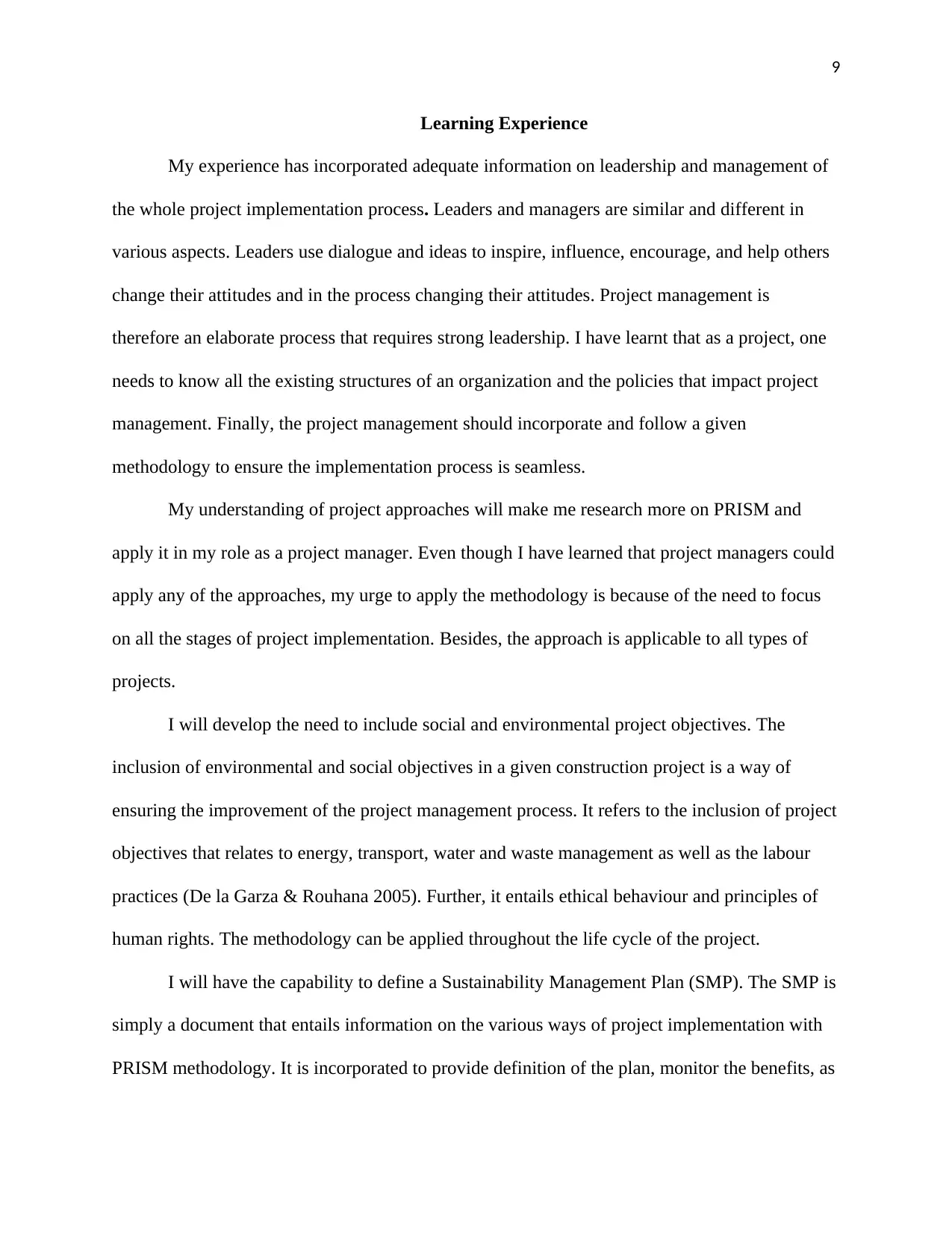
9
Learning Experience
My experience has incorporated adequate information on leadership and management of
the whole project implementation process. Leaders and managers are similar and different in
various aspects. Leaders use dialogue and ideas to inspire, influence, encourage, and help others
change their attitudes and in the process changing their attitudes. Project management is
therefore an elaborate process that requires strong leadership. I have learnt that as a project, one
needs to know all the existing structures of an organization and the policies that impact project
management. Finally, the project management should incorporate and follow a given
methodology to ensure the implementation process is seamless.
My understanding of project approaches will make me research more on PRISM and
apply it in my role as a project manager. Even though I have learned that project managers could
apply any of the approaches, my urge to apply the methodology is because of the need to focus
on all the stages of project implementation. Besides, the approach is applicable to all types of
projects.
I will develop the need to include social and environmental project objectives. The
inclusion of environmental and social objectives in a given construction project is a way of
ensuring the improvement of the project management process. It refers to the inclusion of project
objectives that relates to energy, transport, water and waste management as well as the labour
practices (De la Garza & Rouhana 2005). Further, it entails ethical behaviour and principles of
human rights. The methodology can be applied throughout the life cycle of the project.
I will have the capability to define a Sustainability Management Plan (SMP). The SMP is
simply a document that entails information on the various ways of project implementation with
PRISM methodology. It is incorporated to provide definition of the plan, monitor the benefits, as
Learning Experience
My experience has incorporated adequate information on leadership and management of
the whole project implementation process. Leaders and managers are similar and different in
various aspects. Leaders use dialogue and ideas to inspire, influence, encourage, and help others
change their attitudes and in the process changing their attitudes. Project management is
therefore an elaborate process that requires strong leadership. I have learnt that as a project, one
needs to know all the existing structures of an organization and the policies that impact project
management. Finally, the project management should incorporate and follow a given
methodology to ensure the implementation process is seamless.
My understanding of project approaches will make me research more on PRISM and
apply it in my role as a project manager. Even though I have learned that project managers could
apply any of the approaches, my urge to apply the methodology is because of the need to focus
on all the stages of project implementation. Besides, the approach is applicable to all types of
projects.
I will develop the need to include social and environmental project objectives. The
inclusion of environmental and social objectives in a given construction project is a way of
ensuring the improvement of the project management process. It refers to the inclusion of project
objectives that relates to energy, transport, water and waste management as well as the labour
practices (De la Garza & Rouhana 2005). Further, it entails ethical behaviour and principles of
human rights. The methodology can be applied throughout the life cycle of the project.
I will have the capability to define a Sustainability Management Plan (SMP). The SMP is
simply a document that entails information on the various ways of project implementation with
PRISM methodology. It is incorporated to provide definition of the plan, monitor the benefits, as
⊘ This is a preview!⊘
Do you want full access?
Subscribe today to unlock all pages.

Trusted by 1+ million students worldwide
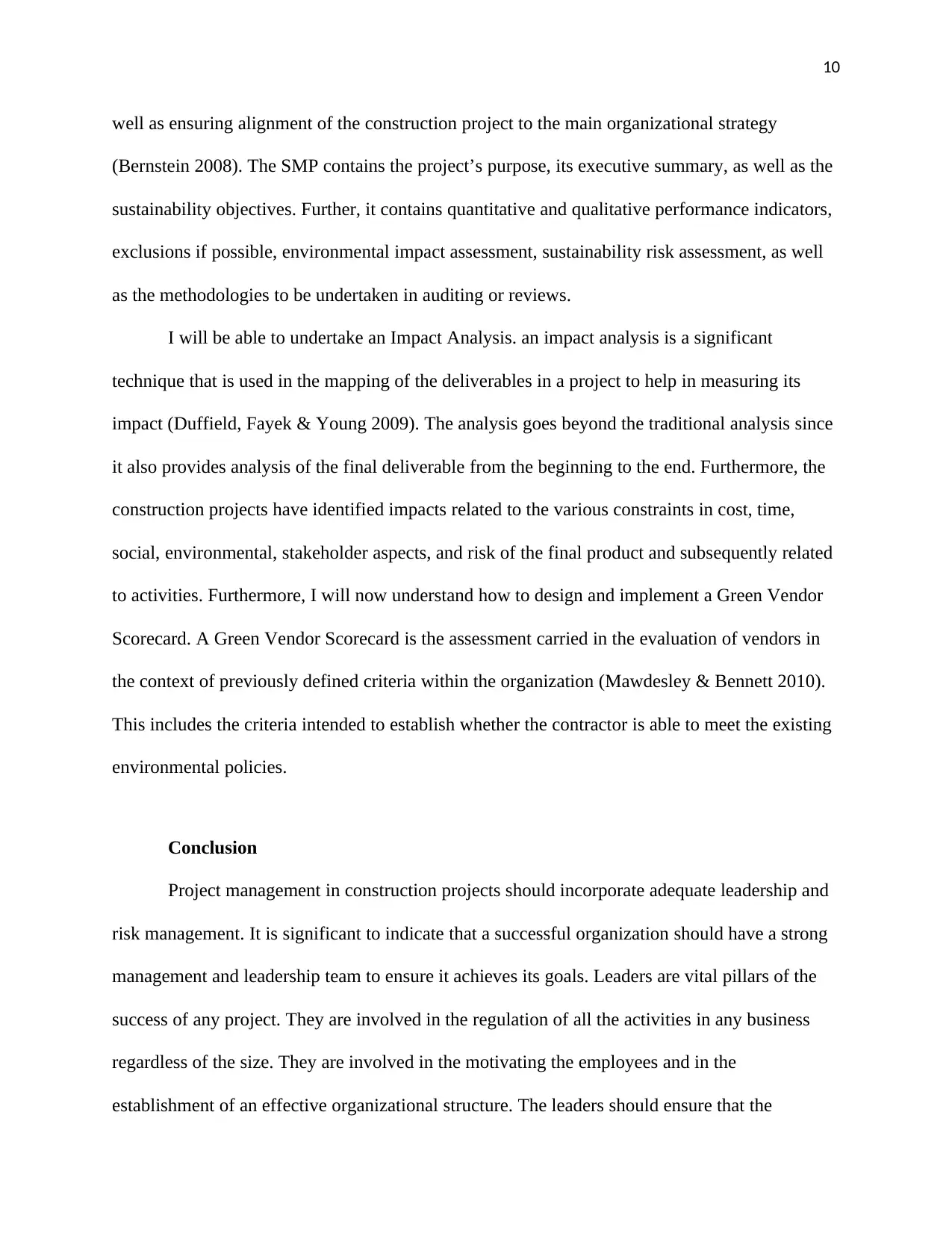
10
well as ensuring alignment of the construction project to the main organizational strategy
(Bernstein 2008). The SMP contains the project’s purpose, its executive summary, as well as the
sustainability objectives. Further, it contains quantitative and qualitative performance indicators,
exclusions if possible, environmental impact assessment, sustainability risk assessment, as well
as the methodologies to be undertaken in auditing or reviews.
I will be able to undertake an Impact Analysis. an impact analysis is a significant
technique that is used in the mapping of the deliverables in a project to help in measuring its
impact (Duffield, Fayek & Young 2009). The analysis goes beyond the traditional analysis since
it also provides analysis of the final deliverable from the beginning to the end. Furthermore, the
construction projects have identified impacts related to the various constraints in cost, time,
social, environmental, stakeholder aspects, and risk of the final product and subsequently related
to activities. Furthermore, I will now understand how to design and implement a Green Vendor
Scorecard. A Green Vendor Scorecard is the assessment carried in the evaluation of vendors in
the context of previously defined criteria within the organization (Mawdesley & Bennett 2010).
This includes the criteria intended to establish whether the contractor is able to meet the existing
environmental policies.
Conclusion
Project management in construction projects should incorporate adequate leadership and
risk management. It is significant to indicate that a successful organization should have a strong
management and leadership team to ensure it achieves its goals. Leaders are vital pillars of the
success of any project. They are involved in the regulation of all the activities in any business
regardless of the size. They are involved in the motivating the employees and in the
establishment of an effective organizational structure. The leaders should ensure that the
well as ensuring alignment of the construction project to the main organizational strategy
(Bernstein 2008). The SMP contains the project’s purpose, its executive summary, as well as the
sustainability objectives. Further, it contains quantitative and qualitative performance indicators,
exclusions if possible, environmental impact assessment, sustainability risk assessment, as well
as the methodologies to be undertaken in auditing or reviews.
I will be able to undertake an Impact Analysis. an impact analysis is a significant
technique that is used in the mapping of the deliverables in a project to help in measuring its
impact (Duffield, Fayek & Young 2009). The analysis goes beyond the traditional analysis since
it also provides analysis of the final deliverable from the beginning to the end. Furthermore, the
construction projects have identified impacts related to the various constraints in cost, time,
social, environmental, stakeholder aspects, and risk of the final product and subsequently related
to activities. Furthermore, I will now understand how to design and implement a Green Vendor
Scorecard. A Green Vendor Scorecard is the assessment carried in the evaluation of vendors in
the context of previously defined criteria within the organization (Mawdesley & Bennett 2010).
This includes the criteria intended to establish whether the contractor is able to meet the existing
environmental policies.
Conclusion
Project management in construction projects should incorporate adequate leadership and
risk management. It is significant to indicate that a successful organization should have a strong
management and leadership team to ensure it achieves its goals. Leaders are vital pillars of the
success of any project. They are involved in the regulation of all the activities in any business
regardless of the size. They are involved in the motivating the employees and in the
establishment of an effective organizational structure. The leaders should ensure that the
Paraphrase This Document
Need a fresh take? Get an instant paraphrase of this document with our AI Paraphraser

11
organization structure based on the organizational goals and objectives. Finally, PRISM (Projects
Integrating Sustainable Methods) is significant methodology that incorporates various aspects of
project management. Therefore, it is the best methodology to incorporate in the management of
projects within the construction sector.
organization structure based on the organizational goals and objectives. Finally, PRISM (Projects
Integrating Sustainable Methods) is significant methodology that incorporates various aspects of
project management. Therefore, it is the best methodology to incorporate in the management of
projects within the construction sector.
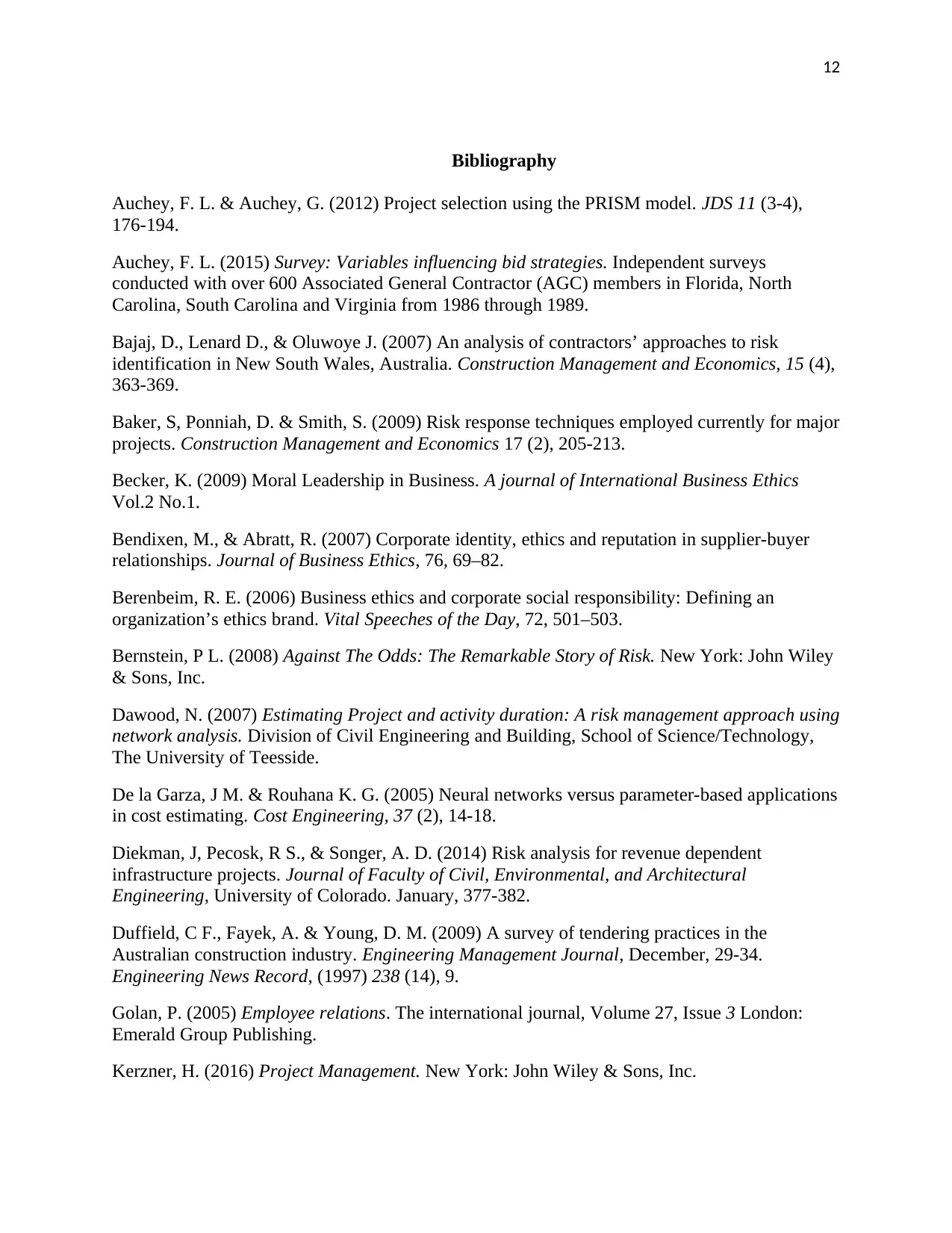
12
Bibliography
Auchey, F. L. & Auchey, G. (2012) Project selection using the PRISM model. JDS 11 (3-4),
176-194.
Auchey, F. L. (2015) Survey: Variables influencing bid strategies. Independent surveys
conducted with over 600 Associated General Contractor (AGC) members in Florida, North
Carolina, South Carolina and Virginia from 1986 through 1989.
Bajaj, D., Lenard D., & Oluwoye J. (2007) An analysis of contractors’ approaches to risk
identification in New South Wales, Australia. Construction Management and Economics, 15 (4),
363-369.
Baker, S, Ponniah, D. & Smith, S. (2009) Risk response techniques employed currently for major
projects. Construction Management and Economics 17 (2), 205-213.
Becker, K. (2009) Moral Leadership in Business. A journal of International Business Ethics
Vol.2 No.1.
Bendixen, M., & Abratt, R. (2007) Corporate identity, ethics and reputation in supplier-buyer
relationships. Journal of Business Ethics, 76, 69–82.
Berenbeim, R. E. (2006) Business ethics and corporate social responsibility: Defining an
organization’s ethics brand. Vital Speeches of the Day, 72, 501–503.
Bernstein, P L. (2008) Against The Odds: The Remarkable Story of Risk. New York: John Wiley
& Sons, Inc.
Dawood, N. (2007) Estimating Project and activity duration: A risk management approach using
network analysis. Division of Civil Engineering and Building, School of Science/Technology,
The University of Teesside.
De la Garza, J M. & Rouhana K. G. (2005) Neural networks versus parameter-based applications
in cost estimating. Cost Engineering, 37 (2), 14-18.
Diekman, J, Pecosk, R S., & Songer, A. D. (2014) Risk analysis for revenue dependent
infrastructure projects. Journal of Faculty of Civil, Environmental, and Architectural
Engineering, University of Colorado. January, 377-382.
Duffield, C F., Fayek, A. & Young, D. M. (2009) A survey of tendering practices in the
Australian construction industry. Engineering Management Journal, December, 29-34.
Engineering News Record, (1997) 238 (14), 9.
Golan, P. (2005) Employee relations. The international journal, Volume 27, Issue 3 London:
Emerald Group Publishing.
Kerzner, H. (2016) Project Management. New York: John Wiley & Sons, Inc.
Bibliography
Auchey, F. L. & Auchey, G. (2012) Project selection using the PRISM model. JDS 11 (3-4),
176-194.
Auchey, F. L. (2015) Survey: Variables influencing bid strategies. Independent surveys
conducted with over 600 Associated General Contractor (AGC) members in Florida, North
Carolina, South Carolina and Virginia from 1986 through 1989.
Bajaj, D., Lenard D., & Oluwoye J. (2007) An analysis of contractors’ approaches to risk
identification in New South Wales, Australia. Construction Management and Economics, 15 (4),
363-369.
Baker, S, Ponniah, D. & Smith, S. (2009) Risk response techniques employed currently for major
projects. Construction Management and Economics 17 (2), 205-213.
Becker, K. (2009) Moral Leadership in Business. A journal of International Business Ethics
Vol.2 No.1.
Bendixen, M., & Abratt, R. (2007) Corporate identity, ethics and reputation in supplier-buyer
relationships. Journal of Business Ethics, 76, 69–82.
Berenbeim, R. E. (2006) Business ethics and corporate social responsibility: Defining an
organization’s ethics brand. Vital Speeches of the Day, 72, 501–503.
Bernstein, P L. (2008) Against The Odds: The Remarkable Story of Risk. New York: John Wiley
& Sons, Inc.
Dawood, N. (2007) Estimating Project and activity duration: A risk management approach using
network analysis. Division of Civil Engineering and Building, School of Science/Technology,
The University of Teesside.
De la Garza, J M. & Rouhana K. G. (2005) Neural networks versus parameter-based applications
in cost estimating. Cost Engineering, 37 (2), 14-18.
Diekman, J, Pecosk, R S., & Songer, A. D. (2014) Risk analysis for revenue dependent
infrastructure projects. Journal of Faculty of Civil, Environmental, and Architectural
Engineering, University of Colorado. January, 377-382.
Duffield, C F., Fayek, A. & Young, D. M. (2009) A survey of tendering practices in the
Australian construction industry. Engineering Management Journal, December, 29-34.
Engineering News Record, (1997) 238 (14), 9.
Golan, P. (2005) Employee relations. The international journal, Volume 27, Issue 3 London:
Emerald Group Publishing.
Kerzner, H. (2016) Project Management. New York: John Wiley & Sons, Inc.
⊘ This is a preview!⊘
Do you want full access?
Subscribe today to unlock all pages.

Trusted by 1+ million students worldwide
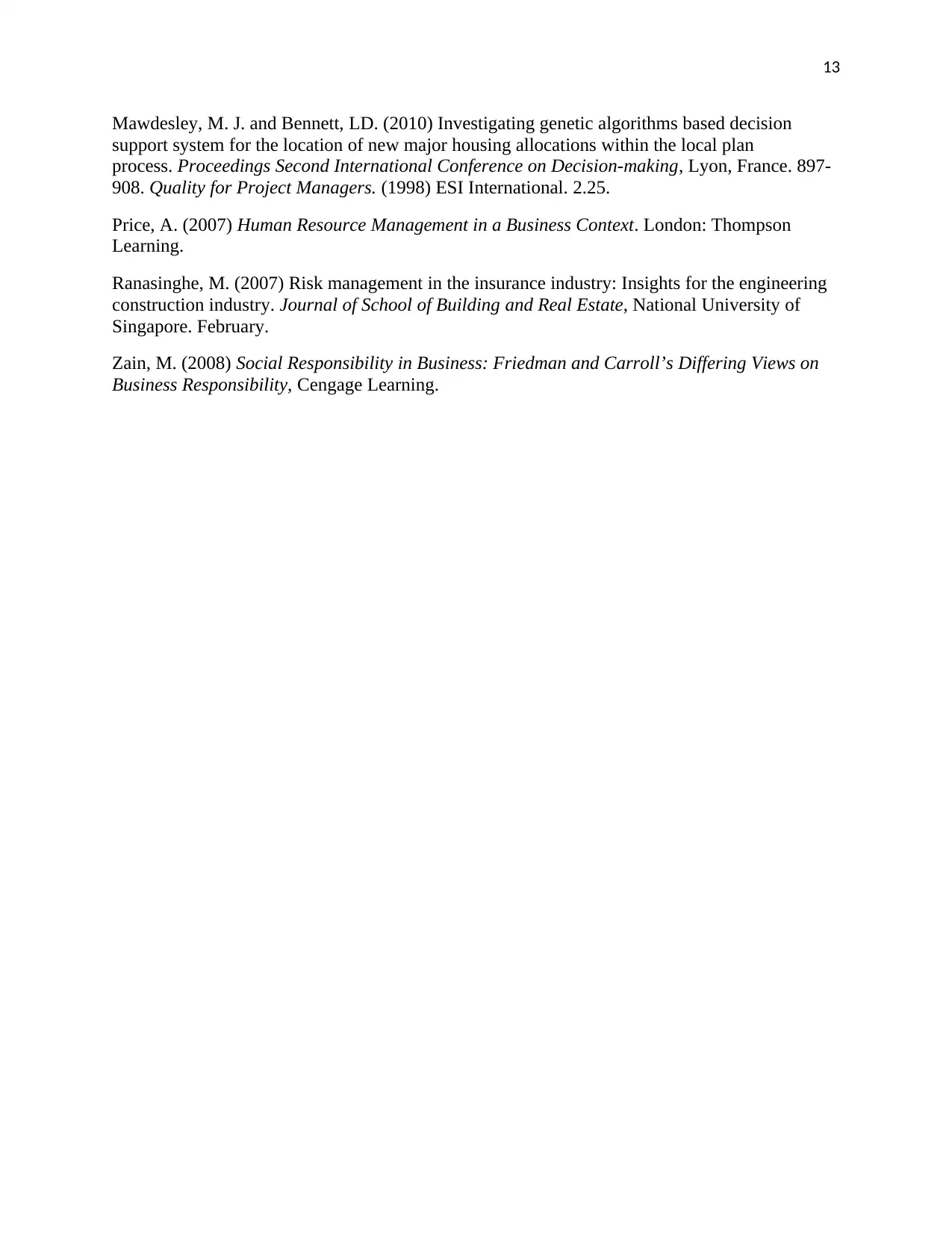
13
Mawdesley, M. J. and Bennett, LD. (2010) Investigating genetic algorithms based decision
support system for the location of new major housing allocations within the local plan
process. Proceedings Second International Conference on Decision-making, Lyon, France. 897-
908. Quality for Project Managers. (1998) ESI International. 2.25.
Price, A. (2007) Human Resource Management in a Business Context. London: Thompson
Learning.
Ranasinghe, M. (2007) Risk management in the insurance industry: Insights for the engineering
construction industry. Journal of School of Building and Real Estate, National University of
Singapore. February.
Zain, M. (2008) Social Responsibility in Business: Friedman and Carroll’s Differing Views on
Business Responsibility, Cengage Learning.
Mawdesley, M. J. and Bennett, LD. (2010) Investigating genetic algorithms based decision
support system for the location of new major housing allocations within the local plan
process. Proceedings Second International Conference on Decision-making, Lyon, France. 897-
908. Quality for Project Managers. (1998) ESI International. 2.25.
Price, A. (2007) Human Resource Management in a Business Context. London: Thompson
Learning.
Ranasinghe, M. (2007) Risk management in the insurance industry: Insights for the engineering
construction industry. Journal of School of Building and Real Estate, National University of
Singapore. February.
Zain, M. (2008) Social Responsibility in Business: Friedman and Carroll’s Differing Views on
Business Responsibility, Cengage Learning.
1 out of 13
Related Documents
Your All-in-One AI-Powered Toolkit for Academic Success.
+13062052269
info@desklib.com
Available 24*7 on WhatsApp / Email
![[object Object]](/_next/static/media/star-bottom.7253800d.svg)
Unlock your academic potential
© 2024 | Zucol Services PVT LTD | All rights reserved.




